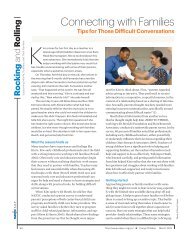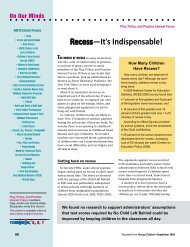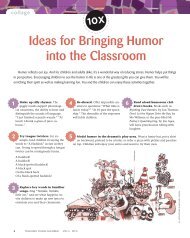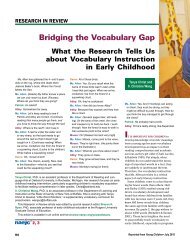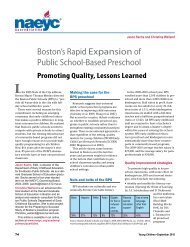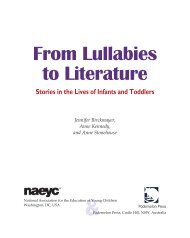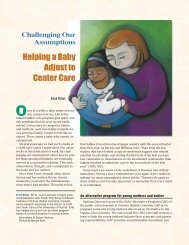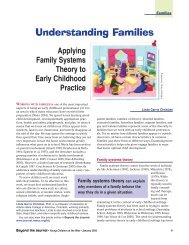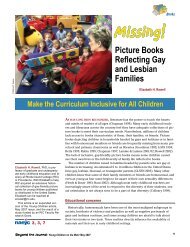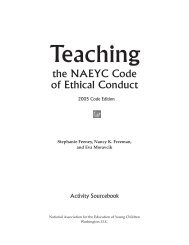The Power of Documentation - National Association for the ...
The Power of Documentation - National Association for the ...
The Power of Documentation - National Association for the ...
Create successful ePaper yourself
Turn your PDF publications into a flip-book with our unique Google optimized e-Paper software.
<strong>the</strong> classroom (Seitz 2006). As children<br />
comment on <strong>the</strong> plant parts, <strong>the</strong><br />
teacher can create a web to record<br />
what <strong>the</strong>y know and to help <strong>the</strong>m<br />
<strong>for</strong>mulate questions. <strong>The</strong> children<br />
might also draw and label <strong>the</strong> various<br />
plant parts.<br />
Presenting <strong>the</strong> topic<br />
and learning<br />
<strong>The</strong> teacher can combine all <strong>of</strong><br />
<strong>the</strong>se pieces to make a documentation<br />
panel. This panel would illustrate <strong>the</strong><br />
children’s knowledge and understanding<br />
more thoroughly than a panel<br />
displaying every child’s worksheet<br />
on plant parts, all <strong>of</strong> <strong>the</strong>ir watercolor<br />
paintings <strong>of</strong> a plant, and every<br />
brainstormed list <strong>of</strong> vegetable plants.<br />
Offering specific examples <strong>of</strong> how<br />
children came to <strong>the</strong>ir understandings<br />
about just one aspect <strong>of</strong> a lesson—in<br />
this case, plant parts—achieves more<br />
than <strong>of</strong>fering an overview <strong>of</strong> several<br />
experiences.<br />
Showing developmental<br />
progress<br />
One important and common topic<br />
<strong>for</strong> documentation is individual child<br />
growth and development. As previous<br />
examples have shown, <strong>the</strong> documenter<br />
is a researcher first, collecting as<br />
much in<strong>for</strong>mation as possible to paint<br />
a picture <strong>of</strong> progress and outcomes.<br />
Documenting individual growth<br />
requires a great deal <strong>of</strong> research, as<br />
<strong>the</strong> teacher must observe each child<br />
in a variety <strong>of</strong> areas <strong>of</strong> development<br />
(such as social-emotional, cognitive,<br />
language, and motor) over a substan-<br />
<strong>The</strong> documenter is a<br />
researcher first, collecting<br />
as much in<strong>for</strong>mation as<br />
possible to paint a picture<br />
<strong>of</strong> progress and outcomes.<br />
tial length <strong>of</strong> time. Only <strong>the</strong>n can <strong>the</strong><br />
teacher create a documentation piece<br />
that tells an accurate story about each<br />
child.<br />
A teacher should be careful to avoid<br />
displaying private or confidential<br />
in<strong>for</strong>mation in public <strong>for</strong>ums. <strong>The</strong>re<br />
are times when documentation may<br />
be more appropriately shared in<br />
o<strong>the</strong>r, more private venues, such as a<br />
portfolio.<br />
Portfolios used <strong>for</strong> individual<br />
assessment <strong>of</strong> children make a particularly<br />
good <strong>for</strong>mat <strong>for</strong> documenting<br />
developmental progress. Teachers<br />
select several domains to research.<br />
<strong>The</strong>y <strong>the</strong>n collect evidence <strong>of</strong> a<br />
child’s interaction with o<strong>the</strong>r children<br />
(photographs and written observations),<br />
record <strong>the</strong> child’s reflections<br />
about <strong>the</strong>ir friendships and cognitive<br />
abilities in interviews or group discussions,<br />
collect work samples, and tie<br />
<strong>the</strong> documentation toge<strong>the</strong>r by writing<br />
a narrative describing <strong>the</strong> child’s<br />
abilities (not deficits) in <strong>the</strong> selected<br />
domains. Even though <strong>the</strong> portfolio<br />
focuses on a child’s abilities, teachers<br />
may want to consider sharing <strong>the</strong><br />
documentation/portfolio in a private<br />
setting, such as a parent/child/teacher<br />
conference, so that parents do not feel<br />
compelled to compare <strong>the</strong>ir child to<br />
o<strong>the</strong>rs in <strong>the</strong> class.<br />
Why should we document?<br />
<strong>The</strong>re are several important reasons<br />
<strong>for</strong> using documentation in early childhood<br />
classrooms.<br />
Showing accountability<br />
Accountability is one reason <strong>for</strong><br />
documentation. Teachers are accountable<br />
to administrators, families,<br />
community members, and o<strong>the</strong>rs,<br />
and documentation helps to provide<br />
evidence <strong>of</strong> children’s learning. In<br />
addition, documentation can improve<br />
relationships, teaching, and learning.<br />
Use <strong>of</strong> this tool helps educators get to<br />
know and understand children, and<br />
it allows <strong>the</strong>m to reflect on <strong>the</strong> effectiveness<br />
<strong>of</strong> <strong>the</strong>ir teaching practices<br />
(Kroeger & Cardy 2006).<br />
Extending <strong>the</strong> learning<br />
Consider <strong>the</strong> following example <strong>of</strong><br />
how one thoughtful teacher could use<br />
documentation to prolong and extend<br />
an unexpected learning opportunity. A<br />
group <strong>of</strong> children finds some miscellaneous<br />
nuts and bolts on a playground,<br />
and <strong>the</strong>ir teacher, noting <strong>the</strong>ir curiosity,<br />
carefully observes <strong>the</strong>ir responses<br />
and listens to and documents <strong>the</strong>ir<br />
90 Young Children • March 2008





